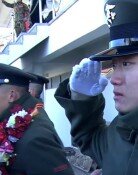N. Korean launches 8 missiles from 4 locations
N. Korean launches 8 missiles from 4 locations
Posted June. 06, 2022 07:40,
Updated June. 06, 2022 07:40
North Korea launched on Sunday eight short-range missiles onto the East Sea from four locations – Sunan in Pyongyang, Dongchang-ri in North Pyongan Province, Kaechon in South Pyongan Province, and Hamhung in South Hamgyong Province. Two missiles were launched from each location. It is North Korea’s 18th armed provocation this year and the third since the inauguration of the Yoon Suk-yeol administration. The most recent one came just a day after South Kore Son Heung-min to play his 100th A match against Chile and the U.S. conducted a joint marine training mobilizing nuclear-powered aircraft carriers of the U.S. in the sea near Okinawa, Japan based on the prediction that North Korea’s seventh nuclear test is imminent. South Korea, the U.S., and Japan condemned North Korea’s provocations and resolved to strengthen their defense posture and deterrence power against the North.
North Korea’s missile provocation on Sunday is likely to have been an attempt to see how South Korea and the U.S. respond by showing off its capability for simultaneous sudden strikes ahead of a nuclear test, which has been fully prepared. The North also launched three missiles, including an intercontinental ballistic missile, as soon as U.S. President Joe Biden finished his visits to South Korea and Japan at the end of last month. This time, armed provocations were carried out with more diversified places of launch and missile types soon after South Korea and the U.S. finished marine training. It was the North’s attempt to show off that various locations in the country are the forts to launch nuclear strikes against South Korea and show determination that it won’t give in to South Korea, the U.S., and Japan’s pressure on the country.
It is likely that North Korea will launch nuclear tests following a plenary meeting of the Workers' Party of Korea, which will be held in the first half of this month. External provocations can be North Korea’s habitual choice to address its residents’ complaints about struggling with COVID-19. However, as a nuclear test is a high level of provocation that even China and Russia cannot defend, the North is considering when to conduct the test. The country has been engaging in opportunistic provocations, riding the new cold war that has been accelerating. Therefore, some predict that the country will conduct a nuclear test when the western countries’ voice of solidarity grows at a NATO summit, which will be held at the end of this month and is likely to be attended by South Korean President Yoon, while China and Russia stand by.
However, North Korea’s nuclear provocations are a dangerous gamble that would isolate itself. It was confirmed that the U.S. has forward-deployed a formation of strategic bombers. B-1B bombers’ late-night flight over the international waters north of the Northern Limit Line following North Korea’s sixth nuclear test in 2017 put the Kim Jong Un regime in an emergency situation. The North’s nuclear provocations will lead the ROK-US combined forces to strengthen their readiness for combat and bring the U.S. military’s strategic assets to the Korean Peninsula. They will be targeting North Korea’s nuclear and missile facilities, as well as the office of the Worker’s Party of Korea and the hiding place of Kim Jong Un.




![‘치매머니 사냥’ 요양원도 휩쓸어…통장 텅 비어 간식비도 못내 [히어로콘텐츠/헌트③-上]](https://dimg.donga.com/c/138/175/90/1/wps/NEWS/IMAGE/2025/12/16/132980393.1.jpg)


